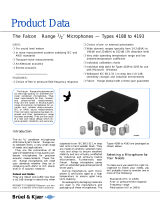The following performance data apply, to the extent that nothing else is indicated, under standard conditions
(Ambient temperature = 25 °C, Constant current = 4 mA).
Dynamic
Sensitivity, nom. (at 80 Hz): 100 mV/g ±10 %
Frequency response: 0,5 Hz .. 13 kHz: ±3 dB
1,5 Hz .. 10 kHz: ±10 %
Measurement range: 60 g Peak
Resonance frequency: typically 30 kHz
Amplitude linearity: < 1 %
Cross sensitivity: typically 5 %
Electric
Maximum output voltage: 27 V
Constant current supply
(secure against reverse polarity): 2 mA .. 10 mA (24 V nom.)
Output resistance: 100
Bias voltage: typically 12,9 VDC
Across entire temperature range: 12,4 VDC .. 13,4 VDC
Grounding: Housing isolated against sensor electronic
Surroundings
Operating temperature range: -55 °C .. +125 °C
Operating temperature
with connection cable AC-140…: -30 °C ... +90 °C
Storage temperature range in original packaging: -20 °C .. +70 °C
Overload capacity: Constant, sinusoidal: 500 g
Shock: 5.000 g
Housing design: Hermetically sealed stainless steel housing
Degree of protection acc. EN 60529: IP68 (2 h at 5 bar) (incl. Nema 6)
(only with connection cable AC-1403 or AC-1404)
Physical values
Measurement principle: Piezoelectric principle, compression type
Weight: 175 g
Housing material: stainless steel 1.4404
Mounting screw: ISO 4762 M6x1 – 30 mm length or¼’’ – 28 UNF x 1 1/4" length
Mounting torque: 3,5 Nm
Connection: M12 plug, male, 4-pole
Order code
AS-668
Accessories
AC-1403: double-wired connection cable with straight plug (M12)
AC-1404: double-wired connection cable with angled plug (M12)


















